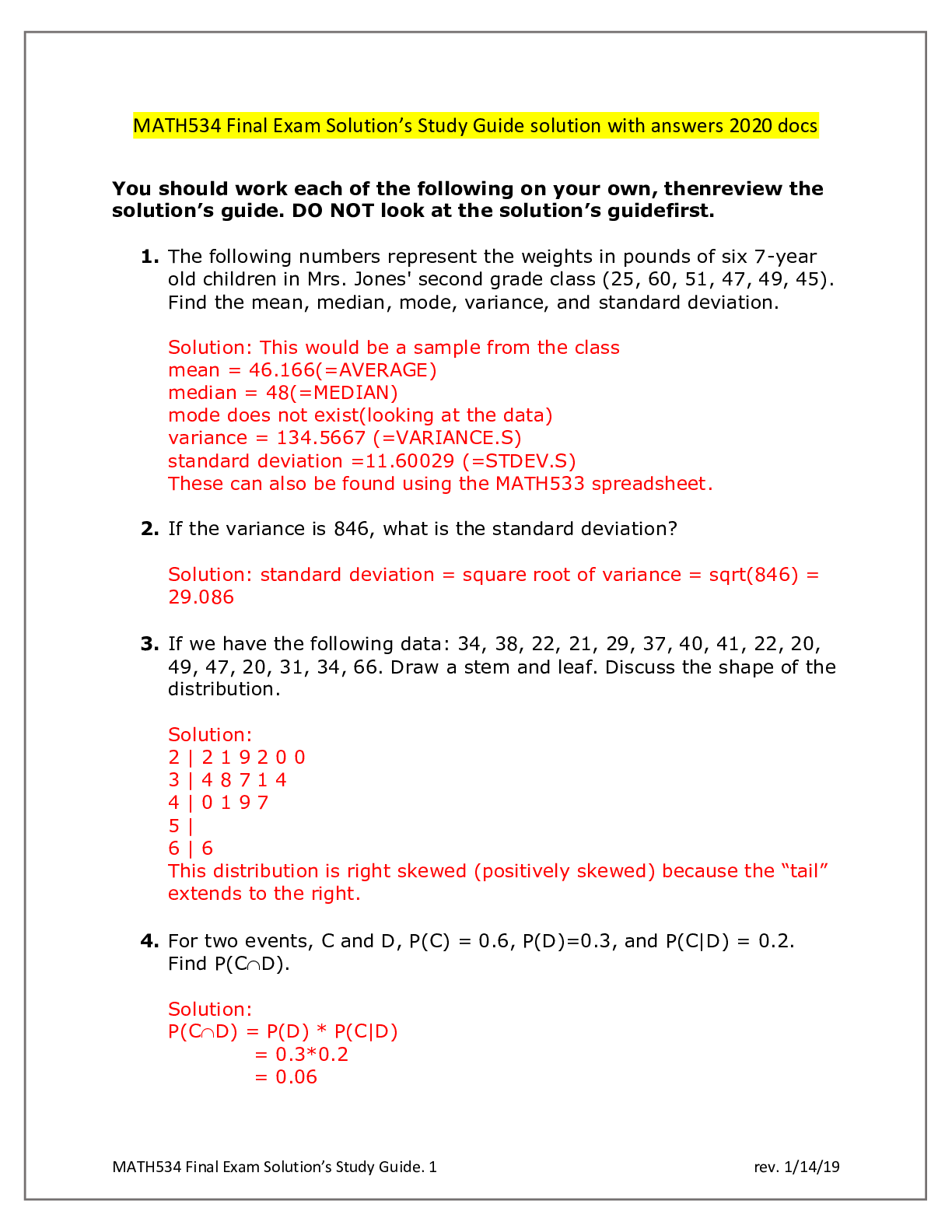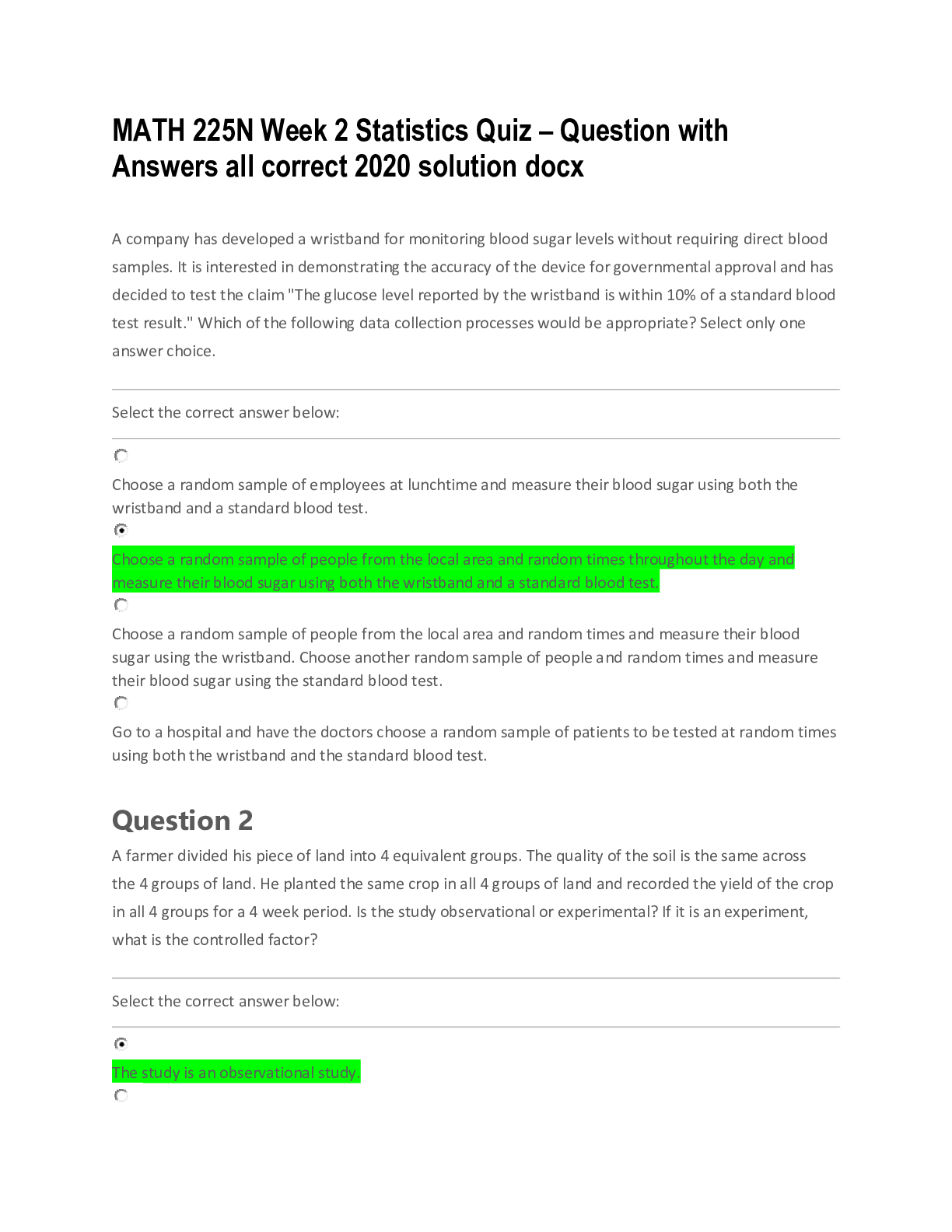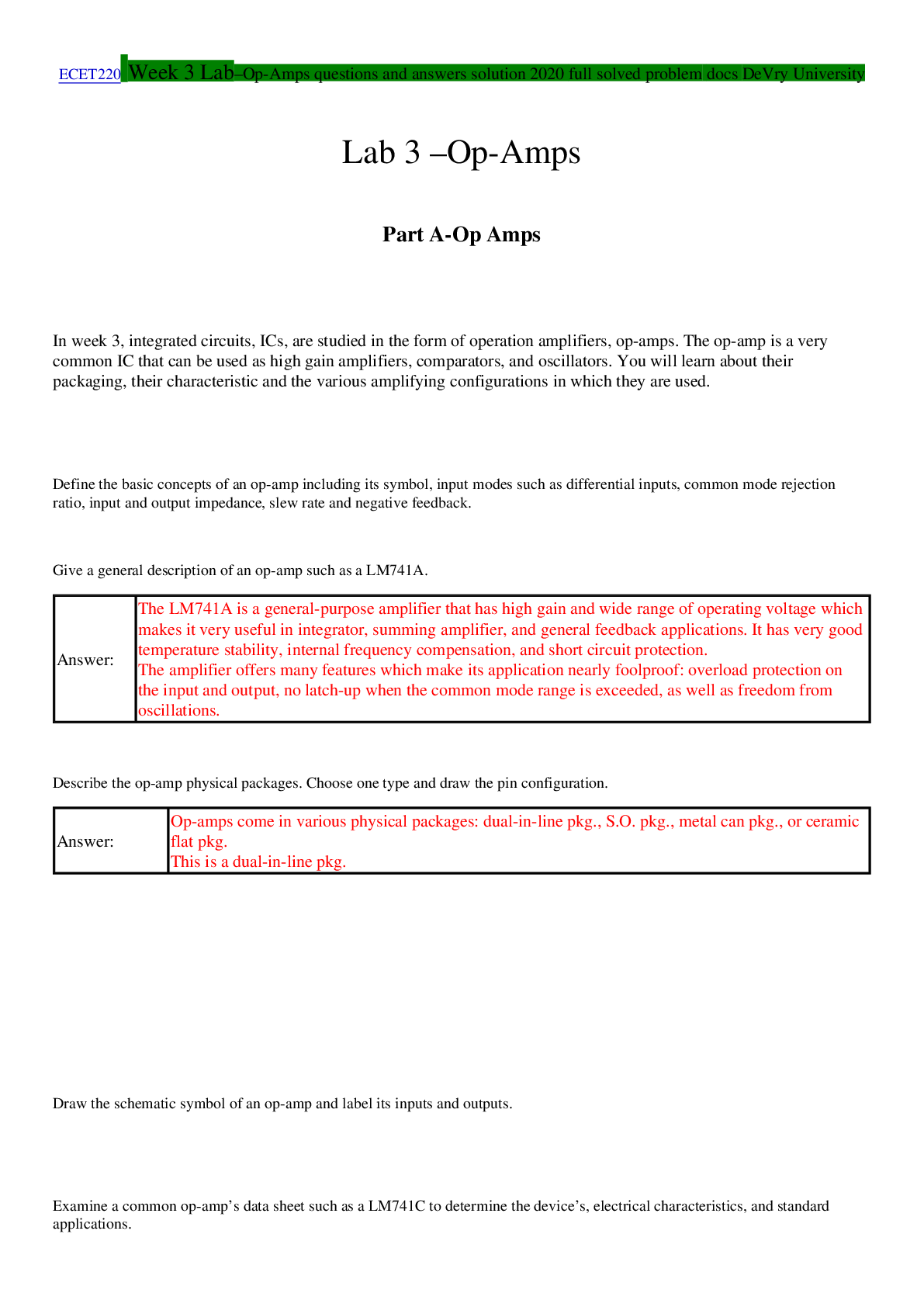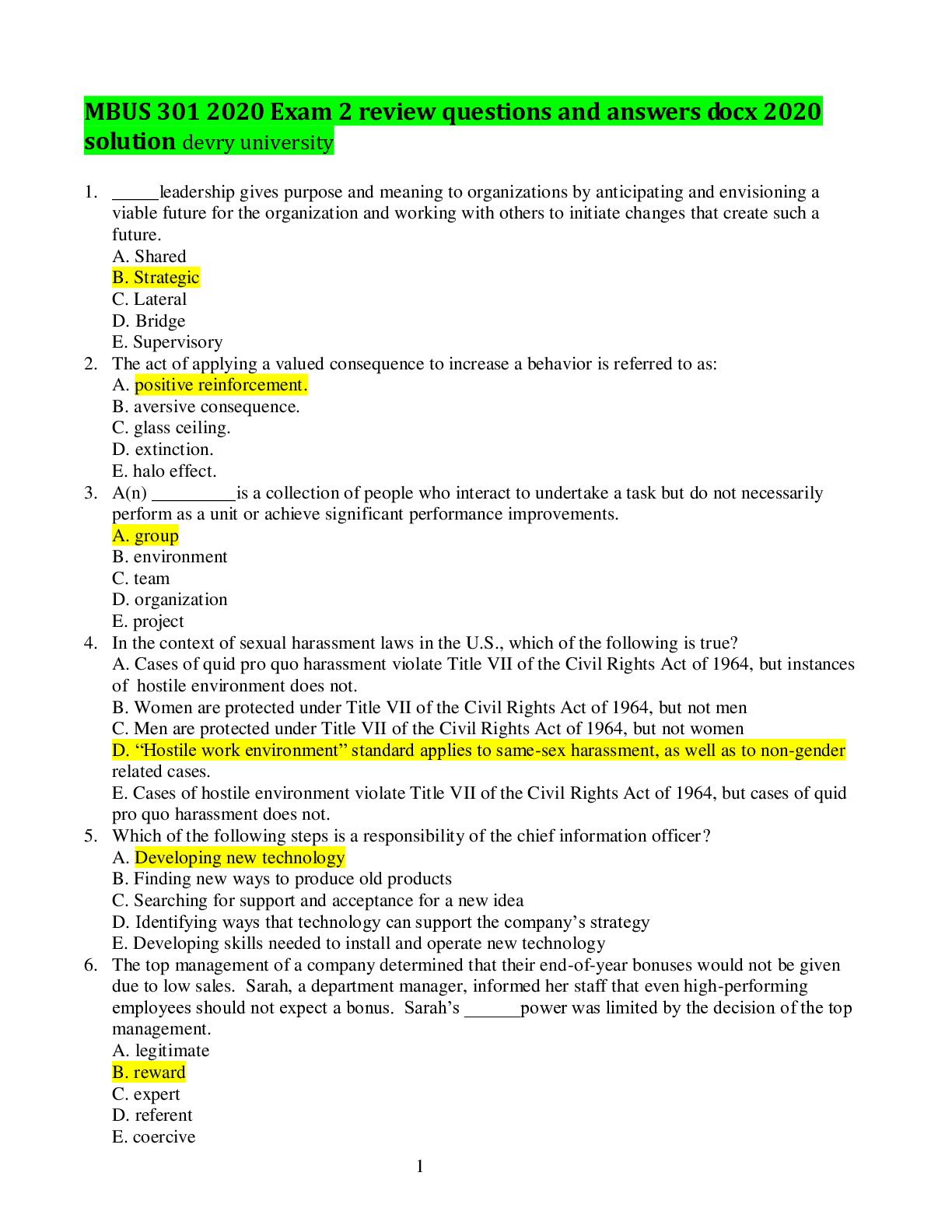BIOS 242 Midterm Exam (Excellence Collection)
Document Content and Description Below
BIOS 242 Midterm Exam (Excellence Collection) Categories BIOS 242 Fundamentals of Microbiology with Lab $20.00 USD Buy Now • Description (BIOS 242 Midterm Exam) BIOS 242 Midterm Exam (S... ummer 2020) 1. Question: Which of the following is ‘not’ a microscopic organism that Leewenhook was able to observe under the microscope he constructed in 1674? 2. Question: Which of the following is INCORRECT regarding Archaea? 3. Question: What is the name for sphere-shaped bacterial cells? 4. Question: Where do you find genetic material in a prokaryotic cell? 5. Question: Which of the following statements is INCORRECT regarding glycocalyces? 6. Question: What is the name for flagella covering the perimeter of the cell? 7. Question: What is the name of the structure that transfers genetic material between bacterial cells? 8. Question: The term used to describe a disease-causing microorganism is 9. Question: If a nursing student observed a typical eukaryotic cell, what would they find inside? 10. Question: Cellular organelles and viruses are very small compared to prokaryotic and eukaryotic cells and are generally measured in ________ 11. Question: Bacteria form endospores under which circumstances? 12. Question: If a microbiology lab technician left safranin out of the Gram stain procedure, what would be the result? 13. Question: A(n) ________ organism is one that requires oxygen for growth and cannot function without it. 14. Question: During the _______ of growth, new cells are being produced at the same rate as the other cells are dying. 15. Question: All of the following are associated with smear preparation except ________. 16. Question: The majority of human pathogens are classified as _________ 17. Question: What process of cellular respiration ultimately produces the most ATP? 18. Question: Anabolic reactions may be characterized as 19. Question: What is the purpose of an enzyme in a chemical reaction? 20. Question: Which eukaryotic organism can have 2 nuclei and contractile vacuoles? 21. Question: Which of the following statements about competitive inhibitors is false? 22. Question: Which Eukaryotic organism obtains nutrients by decomposing dead organisms? 23. Question: Sister chromatids separate and move toward the poles of the cell during ______ of mitosis. 24. Question: The extracellular state of a virus is … a _________. 25. Question: Unknown (Pretty sure this one was about AESAR order) 26. Question: Which viral structure is … from the host cell during viral replication or release? 27. Question: Pyruvic acid is a product of ___________. 28. Question: Which of the following is the most appropriate pairing of microbe and biosafety level? 29. Question: A very large zone of inhibition in the Kirby-Bauer test means _________. 30. Question: Why are endospores … to measure the effectiveness of autoclave sterilization? 31. Question: The major disadvantage to using broad-spectrum antibiotics is that they 32. Question: Why are cell membranes a good target for antimicrobial drugs? 33. Question: Which is not a factor that affects the efficacy of antimicrobial methods? 34. Question: Why does milk go bad after pasteurization? 35. Question: Matching (refer to picture in group chat) ________________________________________ BIOS 242 Week 4 Midterm: Unit 1 – 4 Practice Questions (May 2020) 1. Question: Anabolic reactions characteristics 2. Question: Chemical reactions that can proceed toward either anabolism or catabolism are called what? 3. Question: Catabolic reactions characteristics 4. Question: The molecule that an enzyme acts upon is known as called what? 5. Question: Enzymes known as lyases participate in what reactions? 6. Question: Role of an enzyme in a chemical reaction in a cell? 7. Question: Which are glycolysis steps? 8. Question: What is fermentation? 9. Question: What is Krebs cycle? 10. Question: Anaerobic bacteria use what as final electron acceptors in respiration? 11. Question: The metabolic processes called fermentation produces what? 12. Question: What are electron carrier molecule where are they derived from? 13. Question: When does DNA Replication occurs during cell cycle? 14. Question: When does Sister chromatids separate and move toward the poles of the cell during in mitotic cell division? 15. Question: What is an … pair of homologous chromosomes … ? 16. Question:What is the entire interwoven mass of one multicellular fungal organism … ? 17. Question: Study of fungus is … what? 18. Question: Hyphae are associated with which organism? 19. Question: What are Lichens? 20. Question: Single-celled organisms called ciliates are … ? 21. Question: The kelps are classified as what? 22. Question: What is the function of the outermost layer of a virion? 23. Question: During the intracellular state, a virus exists as what? 24. Question: What determines host specificity of a virus? 25. Question: Describe the stages of a lytic replication cycle in order from earliest to latest 26. Question: What is transduction? it is … with which stages of a bacteriophage infection cycle? 27. Question: The genome of which of the following types of animal virus can act directly as mRNA 28. Question: How are prions different from all other … infectious agents? 29. Question: The infectious particles of fungi have RNA genomes and lack a capsid. They are therefore similar to what? 30. Question: Viruses are shed slowly and steadily during which phase? 31. Question: Describe the mechanism of feedback inhibition and the role this process plays in controlling enzyme activity. 32. Question: Explain why fermentation is a necessary alternative to respiration in many cells 33. Question: Explain why the ATP yield from processes such as cellular respiration is generally … as a theoretical number. 34. Question: A chemical used to reduce potential pathogens on the skin is a(n) 35. Question: A clinical sample labeled “sputum” was collected from 36. Question: A disease that has a steady frequency over time in a particular geographic location is … to as what? 37. Question: A microbiologist inoculates Staphylococcus epidermidisand Escherichia coli into a culture medium. Following incubation, only the coli grows in the culture. What is the most likely explanation? 38. Question: Alcohol-based hand sanitizers specifically target lipids why? 39. Question: An amphibolic reaction is one that _____. 40. Question: An inanimate object that harbors and transmits a pathogen is … what? 41. Question: Antoni van Leeuwenhoek was the first person in history to _____. ________________________________________ BIOS 242 Midterm Exam (Rtd Syllabus) 1. Question : Antoni van Leeuwenhoek was the first person in history to 2. Question : Microbes that can live in the presence or absence of oxygen are … 3. Question : Which of the following scientists provided evidence in favor of the concept of spontaneous generation? 4. Question : The microbial production of alcohol from sugar is … as 5. Question : Which of the following statements concerning Koch’s postulates is false? 6. Question : The study of the body’s defenses against pathogens is … 7. Question : Which of the following is NOT a characteristic of viruses? 8. Question : Saccharomyces cerevisiae is an example of which of the following types of microbes? 9. Question : Proteins that promote chemical reactions in the cell are … 10. Question : Which of the following scientists was the first to develop a taxonomic system for classifying organisms? 11. Question : Robert Koch was … in research on all of the following topics 12. Question : Microorganisms … by the absence of a nucleus are … 13. Question : The term __________ literally means “produces disease.” 14. Question : The study of the causation of disease is … as 15. Question : The study of the occurrence, distribution, and spread of disease is … as 16. Question : Short, hairlike structures … only by eukaryotic cells for movement are … 17. Question : Which of the … is NOT a component of bacterial cell walls? 18. Question : Endospores survive a variety of harsh conditions in part because of the presence of 19. Question : When cells are … in a hypertonic solution, they lose water and shrivel. This process is called 20. Question : All of the following are common to both the Gram stain and the acid-fast stain 21. Question : A patient suffering from tuberculosis could … by use of the __________ stain. 22. Question : Carbolfuchsin is the __________ in the acid-fast stain. 23. Question : The kingdoms … in the Linnaeus system are 24. Question : The rules of naming organisms are … 25. Question : In the Gram stain procedure, iodine serves as a 26. Question : Crystal violet is the __________ in the Gram stain. 27. Question : The __________ makes use of malachite green. 28. Question : The molecule that an enzyme acts upon is … as its 29. Question : Pyruvic acid is a product of 30. Question : In microbiology, the term growth usually refers to an increase in 31. Question : Human pathogens are classified as 32. Question : Organisms that can grow with or without oxygen present are 33. Question : Another term for the logarithmic growth of bacterial cells is 34. Question : During the __________ of growth, cells are dying faster than new cells are being …. 35. Question : Metabolic activity is at maximum level in the __________ of growth. 36. Question : Cells are rapidly growing and dividing during the __________ of growth. 37. Question : Microaerophiles are microbes that grow best at low 38. Question : An acidophile thrives under conditions of low 39. Question : The bacterial chromosome is 40. Question : Which of the following is an example of sanitization? 41. Question : Aseptic means 42. Question : Which of the following is a sterilizing agent? 43. Question : The process of filtration is a(n) 44. Question : Which of the following is NOT a characteristic of a genus name? 45. Question : Acidic dyes 46. Question : All of the following are … with smear preparation Question 47. Question : The Gram stain works because of differences in the __________ of bacteria. 48. Question : The metabolic processes called fermentation 49. Question : Which of the following is an incorrect pairing? 50. Question : Who discovered penicillin? • [Show More]
Last updated: 1 year ago
Preview 1 out of 7 pages
Instant download
.png)
Buy this document to get the full access instantly
Instant Download Access after purchase
Add to cartInstant download
Reviews( 1 )

by 04Angela · 2 years ago
Document information
Connected school, study & course
About the document
Uploaded On
Oct 17, 2020
Number of pages
7
Written in
Additional information
This document has been written for:
Uploaded
Oct 17, 2020
Downloads
1
Views
108

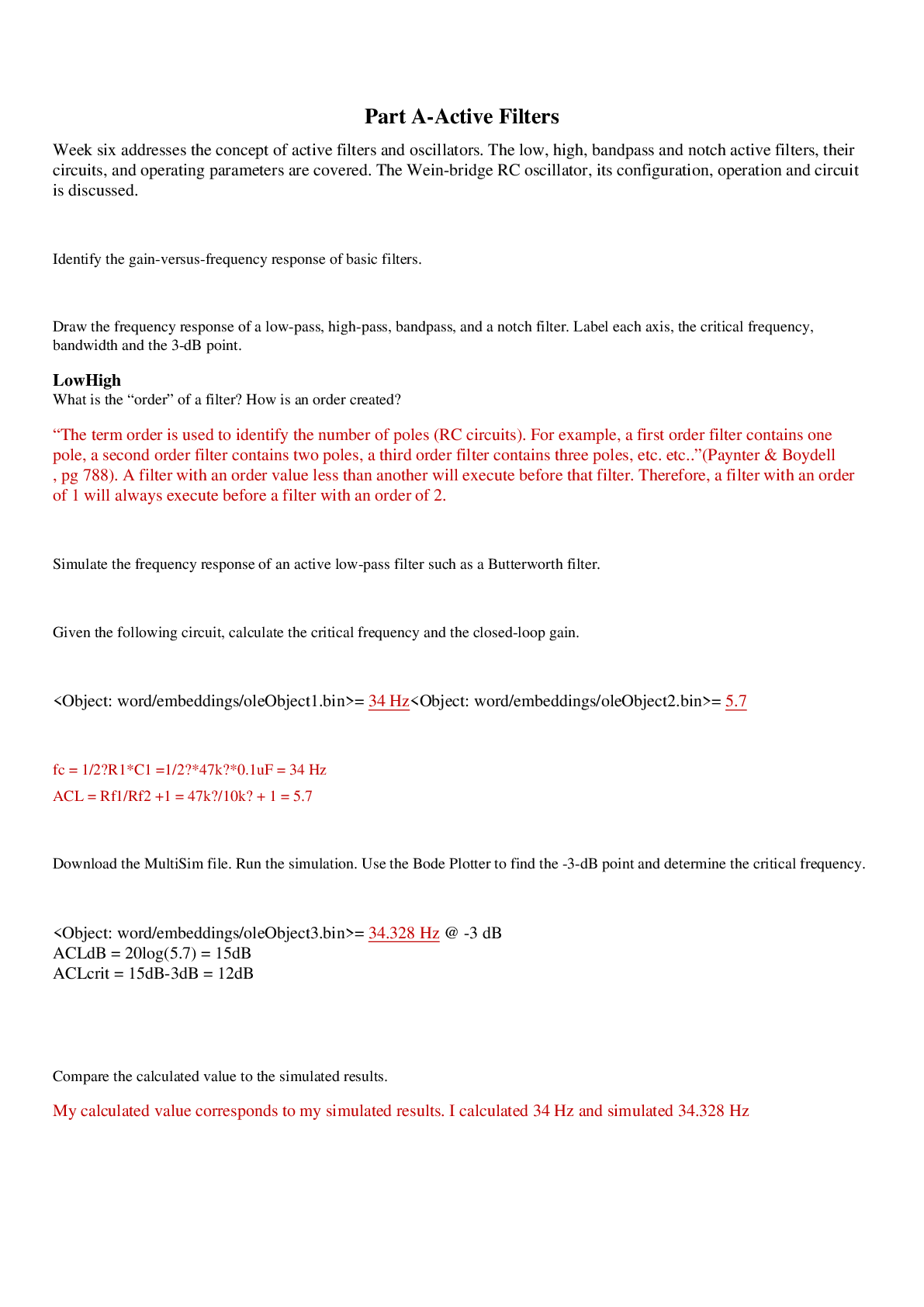
 q and s (1).png)
.png)
 ans.png)
